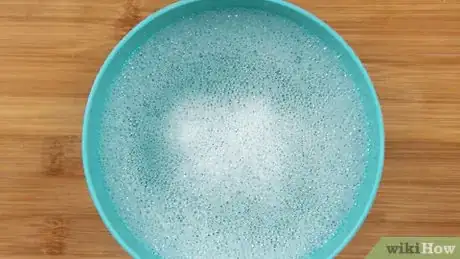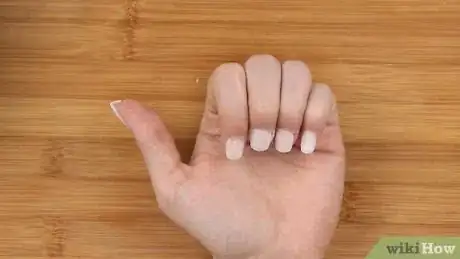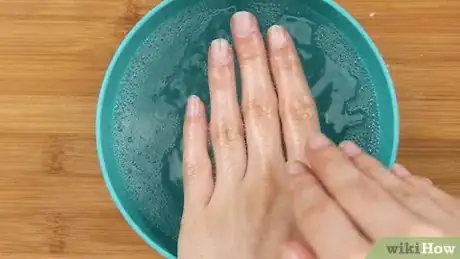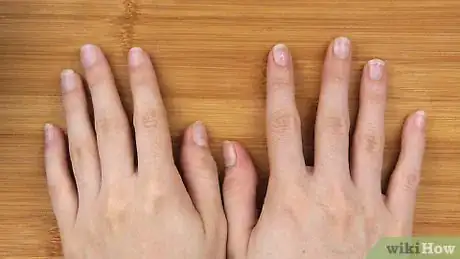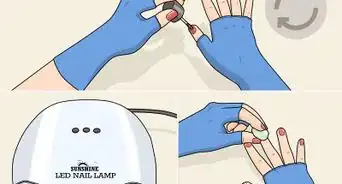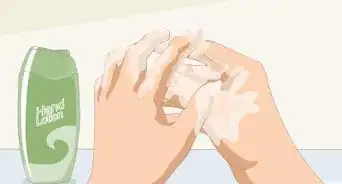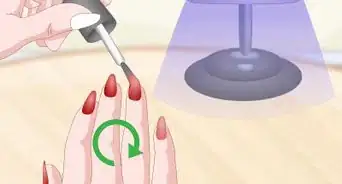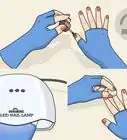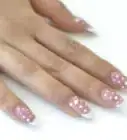This article was co-authored by Mia Rubie. Mia Rubie is a Nail Artist and the Owner of Sparkle San Francisco, a nail studio based in San Francisco, California. She has over eight years of nail artist and management experience and is known for her push-the-envelope designs and artistic eye for colors. Her clients include Sephora, Target, and Vogue. Her work has been featured in the San Francisco Chronicle and StyleCaster. She holds a BBA focusing on Entrepreneurial and Small Business Operations from San Francisco State University. You can find her work on her Instagram account @superflynails.
There are 10 references cited in this article, which can be found at the bottom of the page.
This article has been viewed 694,524 times.
Fake nails look great but can be a little tricky to remove if you haven’t done it before. Either go to a salon to remove the nail glue or attempt it yourself at home. If you have glue-on nails or tips, you can gently file them off after soaking them in soapy water. Next, remove any residual glue with a nail buffer and some acetone. For acrylic nails, simply use acetone to remove the fake nails and file off any remaining gluey residue. Before you know it, you’ll be left with strong and healthy natural nails.
Steps
Removing Fake Nails without Acetone
-
1Soak your nails in warm, soapy water for 15 minutes. Fill a bowl or sink basin with warm water and a little gentle hand soap. Place your hands in the bowl or basin so that your glue-on nails are completely submerged in the water, and keep them there for about 15 minutes.
- The soap and water will soak into the nail glue and soften it, making it easier to remove the nails.
- You can also soak your nails in a little pure acetone to soften the glue, but be aware that acetone is much harsher on your skin, nails and cuticles than soap and water.[1]
- Alternatively, soften up your nail glue by putting a few drops of cuticle oil on each false nail and letting it soak in for a few seconds.[2]
-
2Pry off the fake nails gently once the glue has softened. Look for a spot where the nail has already begun to detach, and gently begin prying off the nail from that spot. If you can’t find a loose spot, carefully work the tip of a nail file under the edges of the fake nail to loosen it.
- Don’t try to yank the nail off if it doesn’t pry loose easily. Soak the nail in soapy water for a few more minutes if you need to soften up the glue a little more.
Advertisement -
3Use a nail buffer to carefully file off excess glue. Once the false nails are off and your natural nails have dried out a bit, use the “buff” side of a nail buffer block to buff away most of the glue. When you’re satisfied that you’ve removed most or all of the glue, rinse away the powder with water.[3]
- If you like, you can then use the “shine” side of the buffer to polish up your nails after buffing them.
-
4Take off any remaining glue with acetone. Soak a cotton ball in acetone and rub it on each fingernail to remove any residual traces of nail glue. Wash your hands with soap and water to rinse away the acetone and any other residues on your hands and nails.
- If your nails feel dry after you’ve rubbed them with acetone, apply a little nail moisturizer or cuticle oil.[4]
Removing Fake Nails with an Acetone Soak
-
1Trim your false nails down as far as possible. Acrylic nails are made of materials that adhere directly to your natural nails instead of being stuck on with glue. Use a pair of nail scissors or clippers to trim the false nails down to a short but comfortable length, without cutting off any of your natural nails. This will make the rest of the removal process quicker because there will be less material to dissolve. [5]
- Don’t trim down into your nail bed as this will be painful.
- This process works for SNS (dipping powder nails), and acrylic nails.
-
2File off the glossy surface of the false nail. If the acrylic nails are still attached to your natural nails, use a nail file to remove the shiny surface. Rub the file back and forth across your nails until the glossy surface is gone and the nails look matte. Try to rub each part of the nail evenly. This will make the removal process quicker and more effective.[6]
- If you see any of your natural nails coming through under the fake nails, stop filing that spot. If you continue to file, you risk damaging your natural nails.
-
3Wipe off any dust with a clean, dry cloth. A microfiber cloth is an inexpensive and effective option; however, any clean cloth will work. Remove any dust from your nails to make it easier for the acetone to penetrate the remaining acrylic.
-
4Rub petroleum jelly on the skin around your nails. This will help to protect your skin from the acetone. Apply a thin layer to your nails beds and the skin below and around your nails.[7]
- If you have dry or sensitive skin, apply the petroleum jelly liberally.
-
5Wrap each of the nails on 1 hand in a cotton ball dipped in acetone. If your acetone comes in a dripper bottle, gently squeeze it onto the cotton pads. If the acetone comes in a regular bottle, you will need to pour it into a small disposable bowl and then dip the cotton pads into the bowl. Place each soaked cotton pad over 1 of your nails.[8]
- If you don’t have cotton pads, cotton balls will also work.
- Purchase acetone and cotton pads from a pharmacy or a supermarket. If you have sensitive skin, choose an acetone-based nail polish remover that is designed for sensitive skin.
- The fumes from acetone can be toxic, so always use it in well-ventilated areas.
-
6Wrap a piece of aluminum foil around each nail and cotton pad. Tear off a piece of aluminum foil that is approximately 1 inch (2.5 cm) x 2 inches (5.1 cm). Check that the cotton pad is in place and then wrap the foil around the nail and cotton pad.[9]
- The aluminum foil will help trap warmth and moisture so the acetone doesn’t evaporate before the glue has a chance to soften. This speeds up the removal process.
- Repeat the process for all the nails on 1 hand, and then move to the other hand. If you find it difficult to work on your opposite hand while your original hand is still soaking, ask a friend to help you or wait until you have removed the foil and cotton pads before attempting to start the other hand.[10]
-
7Remove the foil and pads after 20 minutes. Set a timer for 20 minutes and let the acetone work its magic. Unravel the foil around your nails and remove the cotton pads. You should notice that that the glue has dissolved and that the false nails have become squishy.[11]
- If the first nail is still covered in glue or the false nails are still firmly in place, leave the foil and pads on for another 15 minutes.
- Be careful not to place the used acetone pads onto wooden or plastic tables as the chemicals will damage the surface.
-
8Push off the squishy false nails with a tea towel. Use a clean kitchen towel to clean off the dissolved residue from the false nails. Apply pressure to the tea towel as you clean the nails but stop if your natural nails start hurting.
- Replace the acetone-soaked cotton balls and foil if the false nails don't come off easily.
-
9Use a nail file to buff away any excess glue or paint. Don’t worry about filing your whole nail. Instead, concentrate on the areas that have remnants of glue. Try your best not to press too hard as you don’t want to file your natural nails.[12]
- Purchase a nail file from a pharmacy. Note that some stores will call them nail buffers.
Treating Your Nails After Removing the Glue
-
1Wash your hands in warm, soapy water. Acetone will dry out your skin if it is left on, so remove it with warm water and natural soap. A natural soap will help to leave the natural oils in your skin.[13]
- Use regular soap if that’s all you have at home.
-
2Rub a natural skin oil over your hands and nails. Removing nail glue from your nails tends to dry out your hands. Rub a natural oil liberally over your nails, cuticles, and hands to restore their natural moisture.[14]
- Almond oil and olive oil are good natural nail moisturizers. Purchase these from a natural health and beauty store or from a pharmacy.
-
3Give your nails a breather between manicures. If you wear false nails a lot, your natural nails will benefit from taking a break between applications. After you remove the false nails, give your real nails a few days to a week to recover before adding any new false nails or paint.[15]
- Try taking a week-long break every 8 weeks between manicures.
- Consider applying fake nails without glue next time, to see whether this works better for you than having to deal with nail glue removal.
Expert Q&A
-
QuestionHow do you remove leftover nail glue?
 Laura MartinLaura Martin is a Licensed Cosmetologist in Georgia. She has been a hair stylist since 2007 and a cosmetology teacher since 2013.
Laura MartinLaura Martin is a Licensed Cosmetologist in Georgia. She has been a hair stylist since 2007 and a cosmetology teacher since 2013.
Licensed Cosmetologist You can buff away clumps of nail glue. Small amounts of residue can be removed with acetone.
You can buff away clumps of nail glue. Small amounts of residue can be removed with acetone. -
QuestionHow do you remove fake nail glue?
 Laura MartinLaura Martin is a Licensed Cosmetologist in Georgia. She has been a hair stylist since 2007 and a cosmetology teacher since 2013.
Laura MartinLaura Martin is a Licensed Cosmetologist in Georgia. She has been a hair stylist since 2007 and a cosmetology teacher since 2013.
Licensed Cosmetologist You can soak it in warm, soapy water for 15 minutes or so and then pry it off. Remove any residual glue with nail polish remover.
You can soak it in warm, soapy water for 15 minutes or so and then pry it off. Remove any residual glue with nail polish remover. -
QuestionWhat removes nail glue from fingers?
 Laura MartinLaura Martin is a Licensed Cosmetologist in Georgia. She has been a hair stylist since 2007 and a cosmetology teacher since 2013.
Laura MartinLaura Martin is a Licensed Cosmetologist in Georgia. She has been a hair stylist since 2007 and a cosmetology teacher since 2013.
Licensed Cosmetologist Acetone is the best thing to remove nail glue from the skin. If you are worried about irritation, you can also soak your fingers in warm soapy water and then rub away the glue.
Acetone is the best thing to remove nail glue from the skin. If you are worried about irritation, you can also soak your fingers in warm soapy water and then rub away the glue.
Things You’ll Need
- Bowl or sink basin
- Warm, soapy water
- Nail buffer or file
- Acetone
- 10 cotton pads
- Aluminum foil
- Soft cloth
- Petroleum jelly
- Soap
- Nail oil
- Tea towel
References
- ↑ https://www.self.com/story/to-acetone-or-not-the-healthie
- ↑ https://www.self.com/story/fake-nails-manicure-tips
- ↑ Mia Rubie. Nail Artist. Expert Interview. 23 April 2020.
- ↑ https://www.nytimes.com/2006/04/06/fashion/thursdaystyles/new-ways-to-moisturize-those-brittle-nails.html
- ↑ https://www.youtube.com/watch?v=h3FW_gJAHUw
- ↑ Mia Rubie. Nail Artist. Expert Interview. 23 April 2020.
- ↑ https://www.youtube.com/watch?v=skssMG9f_lc
- ↑ https://www.liveabout.com/how-to-remove-acrylic-nails-2269795
- ↑ https://www.liveabout.com/how-to-remove-acrylic-nails-2269795
- ↑ https://www.liveabout.com/how-to-remove-acrylic-nails-2269795
- ↑ https://www.thesun.co.uk/fabulous/4036988/remove-acrylic-gel-nails-polish/
- ↑ Mia Rubie. Nail Artist. Expert Interview. 23 April 2020.
- ↑ https://www.liveabout.com/how-to-remove-acrylic-nails-2269795
- ↑ https://wildaboutbeauty.com/how-to-remove-acrylic-nails/
- ↑ https://www.refinery29.com/gel-manicure-nail-health-effects
About This Article
To remove glued-on fake nails without using acetone, start by soaking your nails in warm, soapy water for 15 minutes. This will help soften the glue so you can peel the nails off more easily. Once the glue has softened a bit, check for a spot on each nail where it has already started to detach. Carefully work a nail file under the edge of the nail and pry it off. If it doesn’t come off easily, soak the nail a little longer and try again. When you’re done, let your nails dry, then gently buff away any remaining glue residue with a nail buffer. Rinse your hands to remove the powder and loose glue from your nails. If there’s still any stubborn glue on your nails, rub it away with a cotton ball soaked in acetone, then wash your hands with soap and water. If your nail glue is extra stubborn, or if you’re wearing false nails that adhere directly to your natural nails, such as acrylics, you may need to do an acetone soak. Trim the false nails back as much as you can, then file down the top surface to thin them out. Rub a little petroleum jelly on the skin around each nail to minimize drying. Place a cotton ball soaked in acetone on each fingertip, then wrap your nails and the cotton balls in foil and let them sit for about 20 minutes. Next, wipe the false nails and glue off your fingernails with a clean, dry towel. Buff away any remaining glue once your nails have dried. Then, wash your hands with soap and water. Since the process of removing nail glue can dry out your nails and make them brittle, follow up by rubbing a natural oil on your hands and nails, such as almond oil or olive oil. To keep your nails strong and healthy, give them a chance to breathe for a week or so before applying new false nails. For more tips from our Cosmetology co-author, like how to treat your nails after removing the glue, read on!
